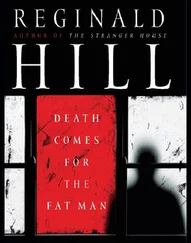YOU ARE THEREFORE COMMANDED, between the hours of 6:00 A.M. and 9:00 P.M. to make an immediate search of the ground floor rear of premises 1211 King’s Circle, occupied by Sanford Elliot and of the person of Sanford Elliot and of any other person who may be found to have such property in his possession or under his control or to whom such property may have been delivered, for a size twelve, right-footed, white tennis sneaker, and if you find such property or any part thereof to bring it before me at the Criminal Courts Building in this county.
This warrant must be executed within ten days of the date of issuance.
Elliot read the warrant, checked the date and the signature of the supreme court justice, and then said, “ What sneaker? I don’t know what you’re talking about.”
Carella looked down at his right foot. Elliot was no longer wearing the sneaker; instead, there was a leather sandal on his foot.
“You were wearing a sneaker the last time I saw you. That search warrant gives me the right to look for it.”
“You’re out of your mind,” Elliot said.
“Am I?”
“I’ve never worn sneakers in my life.”
“I’ll just look around, if you don’t mind.”
“How can I stop you?” Elliot said sarcastically, and went back to work.
“Want to tell me about the wax?” Carella said. He was roaming the studio now, looking for a closet or a cupboard, the logical places one might put a sneaker. There was a second curtain hanging opposite the door leading to the shop, and Carella figured it might be covering the opening to a closet. He was mistaken. There was a small sink-refrigerator-stove unit behind the curtain. He stepped on the foot lever to open the refrigerator door and discovered that it was full of arms, legs, breasts, and heads. They had all been rendered in wax, to be sure, but the discovery was startling nonetheless, somewhat like stumbling upon the remains of a mass Lilliputian dismemberment. “What are these?” Carella said.
“Parts,” Elliot answered. He had obviously decided not to be cooperative, responsive, or even polite. His attitude was not exactly surprising; his visitor had come into the studio with a piece of paper empowering him to go through the place from top to bottom.
“Did you mold them?”
“Yes,” Elliot said.
“I suppose you keep them in here so they won’t melt.”
“Brilliant.”
“Why do you keep them at all?”
“I made up a batch from rubber molds,” Elliot said. “I use them as prototypes, changing them to fit a specific pose.”
Carella nodded, closed the refrigerator, and began wandering the studio again. He found what he thought was a packing crate, but when he lifted the lid he discovered that Elliot stored his clothes in it. He kneeled and began going through the crate, being careful not to disturb the order in which blue jeans and sweaters, shirts and socks, underwear and jackets were arranged. A single sandal was in the crate, the mate to the one Elliot was now wearing. There were also two pairs of loafers. But no sneaker. Carella put the lid onto the crate again.
“Why do you model in wax if it’s so perishable?” he asked.
“I told you, I only do it when I’m going to be casting in bronze.” Elliot put down the wire-end tool in his hand, turned to Carella, and patiently said, “It’s called cire perdue , the lost-wax method. A mold is made of the piece when it gets to the foundry, and then the wax is melted out, and molten bronze is poured into the mold.”
“Then the original wax piece is lost, is that right?”
“Brilliant,” Elliot said again, and picked up a fettling knife.
“What do you do when you get the bronze piece back?”
“Chisel or file off the fins, plug any holes, color it, polish it, and mount it on a marble base.”
“What’s in here?” Carella asked, indicating a closed door.
“Storage.”
“Of what?”
“Larger pieces. Most of them in plaster.”
“Mind if I take a look?”
“You’re hot stuff, you know that?” Elliot said. “You come around with a search warrant, and then you go through the charade of asking me whether or not you can...”
“No sense being uncivilized about it, is there?”
“Why not? I thought you were investigating a murder.”
“I didn’t think you realized that, Mr. Elliot.”
“I realize it fine. And I’ve already told you I don’t know who the dead man...”
“Yes, you’ve already told me. The trouble is, I don’t happen to believe you.”
“Then don’t be so fucking polite,” Elliot said. “If I’m a murder suspect, I don’t need your good manners.”
Carella went into the storage room without answering. As Elliot had promised, the room contained several larger pieces, all done in plaster, all unmistakably of Mary Margaret Ryan. A locked door was at the far end of the room. “Where’s that door go?” Carella asked.
“What?” Elliot said.
“The other door here.”
“Outside. The alley.”
“You want to unlock it for me, please?”
“I don’t have a key. I never open that door. It’s locked all the time.”
“I’ll have to kick it open then,” Carella said.
“Why?”
“Because I want to see what’s out in that alley.”
“There’s nothing out in that alley.”
There were prints in the plaster dust on the floor. Easily identifiable prints left by someone’s right foot; on either side of them, there were circular marks that might have been left by the rubber tips of crutches. The prints led directly to the alley door.
“What do you say, Elliot? Are you going to open it for me?”
“I told you I don’t have a key.”
“Fine,” Carella said, and kicked the door in without another word.
“Are you allowed to do that?” Elliot said.
“Sue me,” Carella said, and went out into the alley. A garbage can and two cardboard boxes full of trash were stacked against the brick wall. In one of the cardboard cartons Carella found the sneaker Elliot had been wearing yesterday. He came back into the studio, showed the sneaker to Elliot and said, “Ever see this before?”
“Never.”
“I figured you wouldn’t have,” Carella said. “Mr. Elliot, at the risk of sounding like a television cop, I’d like to warn you not to leave the city.”
“Where would I go?” Elliot asked.
“Who knows? You seem to have a penchant for Boston. Take my advice and stay put till I get back to you.”
“What do you hope to get from a fucking moldy sneaker?” Elliot said.
“Maybe some wax that didn’t get lost,” Carella answered.
The cop who picked up the surveillance of Frederick Lipton at five o’clock that evening was Cotton Hawes. From his parked sedan across the street from the real estate office, he watched Lipton as he locked up the place and walked down the block to where his Ford convertible was parked. He followed him at a safe distance to a garden apartment a mile and a half from the real estate office, and waited outside for the next four hours, at which time Lipton emerged, got into his Ford again, and drove to a bar imaginatively named the Gee-Gee-Go-Go. Since Lipton had never met Hawes and did not know what he looked like, and also since the place advertised topless dancers, Hawes figured he might as well step inside and continue the surveillance there. The place was no more disappointing than he expected it to be. Topless dancing, in this city, was something more than topless — the something more being pasties or filmy brassieres. Hookers freely roamed the streets and plied their trade, but God forbid a mammary gland should be exposed to some unsuspecting visitor from Sioux City. The dancers, nonetheless, were usually young and attractive, gyrating wildly to canned rock music while the equivalent of front-row center in a burlesque house ogled them from stools lining the bar. Not so at the Gee-Gee-Go-Go. The dancers here were thirtyish or better, considerably over the hill for the kind of acrobatics they performed or the kind of erotic response they attempted to provoke. Hawes sat in bored silence while the elaborate electronics system buffeted him with waves of amplified sound and the dancers, four in all, came out in succession to grind away in tempo along the length of the bar. Keeping one eye on Lipton, who sat at the other end of the bar, Hawes speculated that the sound system had cost more than the dancing girls, but this was Calm’s Point and not Isola; one settled for whatever he could get in the city’s hinterlands.
Читать дальше












